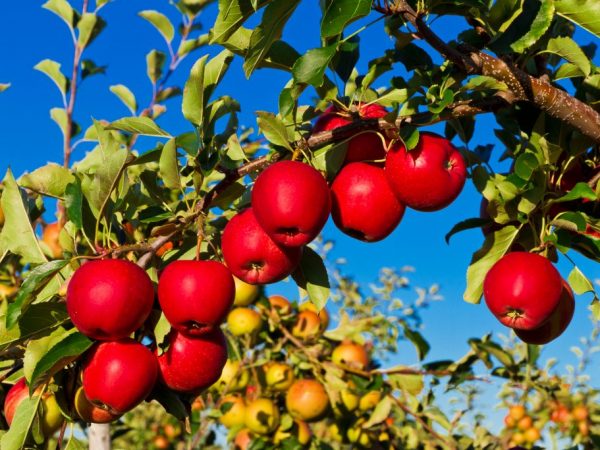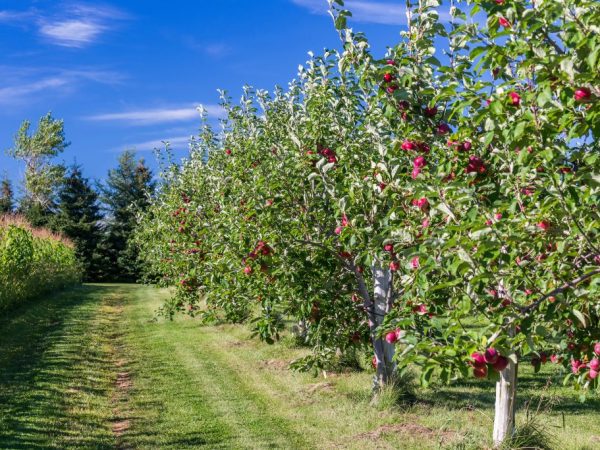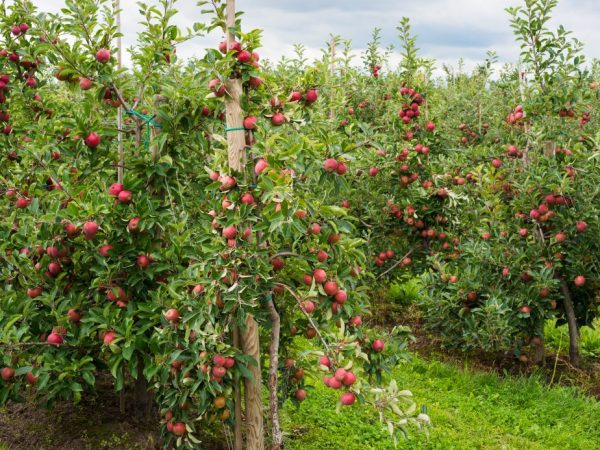Varietal characteristics of the Jonathan apple tree
Jonathan's apples were introduced to the United States at the end of the 19th century. They appeared in Russia in 1954. This variety is often used by Russian and foreign breeders to breed new species. He was the material for the creation of about 40 varieties of apple trees.
- Variety characteristic
- Description of the tree and fruit
- Taste
- Yield
- Pollinators
- Winter hardiness
- Disease resistance
- Tree lifespan
- Growing regions
- Landing
- Timing
- Landing technology
- Care
- Features of ripening and fruiting
- Collection and storage of fruits
- Clones varieties
- Gold (Jonagold)
- Red (Jonared)
- Other clones
- Gardeners reviews

Varietal characteristics of the Jonathan apple tree
Variety characteristic
Trees of the Jonathan variety differ from others in their resistance to severe frosts. Their main distinguishing features are the mottled rind and sugar taste of the fruit.
Description of the tree and fruit
Apple trees Jonathan are medium-sized trees with a spherical crown. Bloom in mid-May. A grayish bloom can be seen on the leaves - this is one of the external differences of the variety. The leaves are small.
The fruits have a greenish tint with a barely noticeable red blush, they are small in size and slightly flattened, oval in shape. An apple weighs from 100 to 150 g, the calorie content is 47 kcal per 100 g.
Taste
The pulp of apples during the period of biological ripeness is light green in color. The taste of the fruit is estimated at 4.4 points out of 5. The pulp is juicy, sweet and aromatic.
According to the description of the Jonathan apple tree, the fruits contain:
- dry substances;
- sucrose;
- titratable acids;
- ascorbic acid;
- P-active substances.
Yield
Apples ripen quite early, already at the end of August they are edible. The record number of apples harvested from one tree was 400 kg. Apple trees of this variety, 15-18 years old, yield about 40-80 kg.
Pollinators
Experienced summer residents consider the best varieties for pollination of the Jonathan apple tree:
- Idared;
- Mac;
- Spartan;
- Ruby Dooks.
Winter hardiness
This variety belongs to the middle class of frost resistance - it tolerates temperatures up to minus 20 ° C without damage. But in winter, in the northern regions, frosts can reach minus 25-30 ° C.
If the tree gets hypothermia, it will not die, but this can negatively affect the formation of fruits. They will not reach the size standard, and biological ripeness will come later.
Disease resistance

Preventive measures will help keep apple trees healthy
The apple tree is not resistant to bacterial cancer and powdery mildew, but it has a high immunity to scab. To reduce the risk of disease, experienced gardeners are advised to carry out preventive treatment of the tree in autumn and spring.
Tree lifespan
The Jonathan apple tree, subject to the rules of planting, cultivation and care, lives for about 100 years. Cold and heat are not a hindrance to the tree. If you take good care of it, including treating it with anti-rodent agents, then it will delight you with its fruits for a very long time.
Growing regions
The apple tree is suitable for growing in any region, because it endures frost and hot summer days. Experienced summer residents recommend planting a tree in the North Caucasus - in this region, for such a variety, the most favorable conditions are.
Landing
The quality and taste of the fruit depends on when the tree was planted and whether it was done correctly. If you make the slightest mistake, you can pay for it with a whole harvest. It is important to know the timing and technology of planting.
Timing
Experienced gardeners say that the best time of the year for planting an apple tree is autumn. Indeed, during the autumn months and frosty winters, the Jonathan apple tree adapts to cold temperatures, so it will be easier for her to adjust to spring weather conditions.
Landing technology
The seedlings must be purchased from specialized gardening stores. So that the fruits do not lose nutrients in the future, when planting a tree, you must:
- cut off 1 cm of the roots of the seedling to refresh them;
- prepare a hole in advance for a tree with a diameter of 1 m, a depth of 50-60 cm;
- before planting, you need to fertilize the soil. For this, compost, humus, bird droppings, peat, ash are used. Fertilizer is applied at the rate of 200-250 g per seedling. The dry matter is diluted with settled water in a 1: 1 ratio, the finished mixture is poured into the well;
- straighten the roots of a young tree, place it in a hole, sprinkle it with earth and tamp it;
- the root collar is left above the ground.
Do not forget to water the tree immediately after planting with 6-8 liters of water.
Care

Trees need regular watering
The Jonathan apple variety is planted in late April - early May. In the second year, you need to prune the crown - to form it. To care for a tree you need:
- water it moderately - once a week;
- Fertilize once every 3 months;
- disinfect it from fungal diseases;
- pruning in early spring.
To prevent fallen leaves and apples from starting to rot, they must be removed from the ground in time.
If the fungus has struck a tree, then it must be treated with special agents such as Fundazol, Topaz, Skor.
Features of ripening and fruiting
At the end of September, the apples begin to sing. The exact ripening period depends on the region in which the tree grows. The weather conditions and the time of year in which Jonathan was planted will directly affect both flowering time and subsequent fruit formation and yield.
The tree begins to delight the gardener with juicy apples from the age of 5, and at 6 years old it gives about 14 kg of harvest. High fruiting depends on the moisture content of the soil.
Collection and storage of fruits
Harvesting can begin in September - October. If you tighten it up, you can harm the tree. Cold resistance and active growth will decrease. During the harvest period, the fruits should be greenish and sour.
To understand that it's time to remove the apples from the tree, pay attention to the color of their seeds: they should turn brown.
The storage conditions are simple: the temperature should be around 3 ° C. If you keep the fruits in the room, then they will not lose their taste and vitamin value.
Clones varieties
Thanks to its taste and other features, the Jonathan apple tree began to appear equally popular and useful clones.
Gold (Jonagold)
Trees have a spherical crown. Resistant to cold weather. They often suffer from bacterial cancer. Fruiting begins at the age of 3 years. Apple tree Gold from 9 to 12 years gives about 40 kg of yield. Fruit color is green-yellow, sometimes orange. Apples ripen at the end of September; harvesting can begin at the end of October.
Red (Jonared)
The crown of the tree is small. It easily tolerates severe frosts. Ripens by the end of September. Jonared's apple has a dark red hue. The clone tastes just as sweet and juicy.
Other clones
There are about 40 such varieties. Most often they differ in color, spotting and winter hardiness. Most popular clones: Idared, McFree, French Prime, Wilmouth, Morens, Jonagored Supra, Excel, Red Jonaprince.
Gardeners reviews
Experienced summer residents and gardeners argue that the official description of the Jonathan apple tree is fully consistent with real indicators. The variety easily tolerates even the most severe winters. The tree adapts well to different types of soil and, with good care, gives a good harvest.

